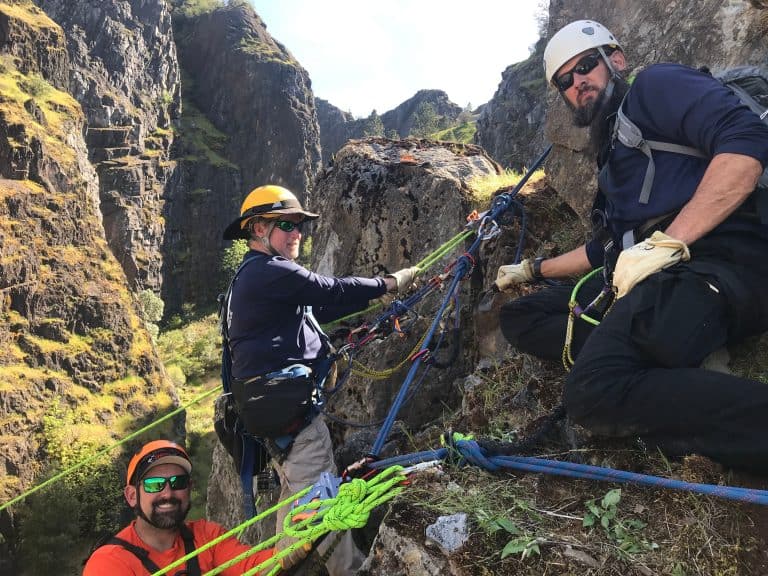Rope Rescue Training for Veterans in Fire Service and SAR
Veteran technicians in fire service and search and rescue (SAR) have already mastered the basics of rope rescue. However, the nature of their work demands that they constantly refine their technical skills, adapt to new equipment and systems, and take on leadership roles. This advanced training pathway offers a deeper, more specialized look at the skills required for complex rescues, focusing on leadership, adaptability, and mastery of high-stakes scenarios.
Pathway Overview: From Refining Core Skills to Leadership Mastery
While new recruits focus on learning foundational skills, veteran technicians work on refining and mastering those same skills, pushing their capabilities and decision-making in more dynamic and unpredictable environments. The veteran pathway is built on the assumption that these technicians are ready to engage with more complex systems and gear, and are often tasked with leading teams through difficult rescues.
LEVEL 1: Strengthening Core Knowledge and Preparing for Advanced Scenarios
Veterans begin by revisiting and enhancing the foundational skills they learned early in their careers. The difference now is in the level of mastery and efficiency required. The aim is to refine these skills to ensure they can be applied quickly and accurately in high-pressure situations.
- The Cornerstone Knowledge & Perception
Veterans focus on improving situational awareness and critical decision-making in complex environments. While new recruits learn to recognize hazards, veterans are expected to anticipate challenges and adapt strategies on the fly.
Progression: Refines foundational skills → Enhances advanced decision-making. - The Art of Rope Rescue Coaching
As veterans, technicians are expected to take on coaching and leadership roles. This course develops the ability to lead new recruits and guide teams in high-stress environments, ensuring consistent communication and team cohesion during complex rescues.
Progression: Builds leadership skills → Prepares for Level 2 and 3 command roles. - Gear In Use 1-8 / Equipment
This course ensures that veterans can maximize the efficiency of their gear in dynamic, evolving situations. They must be capable of rapidly adapting to new equipment or unfamiliar tools, using them effectively in complex scenarios.
Progression: Mastery of technical tools → Prepares for specialized gear in Level 2. - Knots Craft
While new recruits learn essential knots, veterans refine their ability to tie these knots quickly and accurately under pressure. Advanced knot variations are also introduced for more complex rigging operations.
Progression: Refines foundational knots → Leads into complex rigging at higher levels. - Anchors & Anchor Systems
Veterans are trained to set up secure, multi-point anchors in challenging environments, optimizing load distribution for maximum safety and efficiency.
Progression: Optimizes anchor setups → Prepares for complex environments and loads. - Force Multipliers / Mechanical Advantage Theory
Mastery of mechanical advantage systems is essential for efficient rescues. Veterans learn to apply pulleys, progress capture devices, and force multipliers in high-angle, complex rescues.
Progression: Mastery of mechanical systems → Prepares for heavy-load rescues at higher levels. - Edge Safety in Search and Rescue
Advanced edge transitions are critical in high-stakes rescues. Veterans must ensure safety while managing large or delicate loads over difficult terrain.
Progression: Ensures advanced edge safety → Prepares for more challenging rescues in Level 2 and beyond. - Conversations in Rigging
Veterans engage in in-depth discussions on rigging systems, improving their ability to make quick, effective decisions about setups and safety during rescues.
Progression: Deepens rigging knowledge → Essential for leading complex rescues.
LEVEL 2: Specialization and Advanced Technical Mastery
At Level 2, veteran technicians begin to specialize in more complex systems, such as high-directional rigging and confined space rescues. These skills push them beyond the foundational knowledge of Level 1, preparing them for highly technical and dangerous rescues.
- A Guide to AHD and TTRS
Veterans specialize in high-directional rigging (AHD) and twin-tension rope systems (TTRS), vital for rescues in vertical and high-angle environments.
Progression: Prepares for high-angle rescues → Advances to high-stakes scenarios in Level 3. - SAR Advanced High Directional Skill Sets
This course focuses on the advanced use of high-directional systems for technical rescues in extreme environments.
Progression: Specializes in high-directional setups → Prepares for critical SAR missions. - The Vortex Guidebook
Master the Vortex system, a critical piece of equipment in highly technical rescues. Veterans learn how to adapt the system for complex environments.
Progression: Mastery of specialized rigging → Essential for difficult rescues at Level 3.
LEVEL 3: Leadership and High-Stakes Operations
At Level 3, veterans transition into leadership roles. They are now expected to lead teams through high-stakes rescue operations and manage complex scenarios like tower rescues and confined space rescues.
- Horizontal Rigging
Veterans learn to manage horizontal rigging systems for complex rescues, focusing on safety and load balancing in difficult environments.
Progression: Prepares for leading complex rescues → Essential for command roles. - Confined Space Rescue (Awareness, Operations, Technicians)
Confined space rescues are among the most dangerous. Veterans progress through awareness, operations, and technician-level courses, mastering the techniques required for safe and efficient rescues in tight spaces.
Progression: Mastery of confined space operations → Prepares veterans for leadership in specialized teams.
Call to Action
For veterans in fire service and SAR, continuous improvement is essential. With Rigging Lab Academy’s specialized courses, you can refine your skills, take on leadership roles, and master the techniques required for the most complex rescues. Begin your advanced training today and lead your team with confidence.









